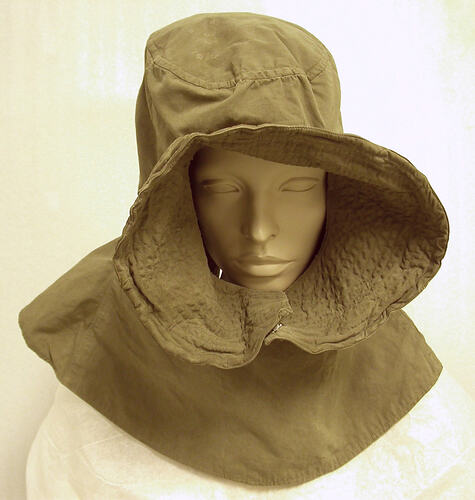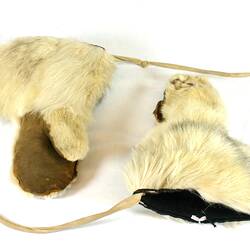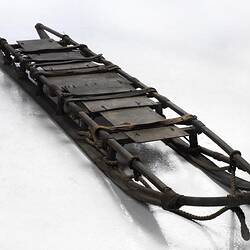Summary
Khaki green hood with round opening for the face, dated 1954-1966. Designed by ANARE (Australian National Antarctic Research Expeditions) for use in Antarctica, circa 1954-1966 as an accessory for earlier ventile suits that did not provide a wind protector for the face.
This is part of Museum Victoria's collection of artefacts from the modern era of scientific exploration of Antarctica.
Physical Description
Khaki green hood with round opening for the face. Consists of five panels extending from a round crown piece. The panels extend approximately to the shoulders, flaring outwards. The face opening features a wire-stiffened panel enforced by machine stitching. This panel extends outwards around the entire opening and is buttoned under the chin with a single plastic tan-coloured button.
Significance
The conditions of Antarctica mean that protective clothing is of particular importance. These conditions are of two main types: wet-cold and dry-cold. Wet-cold conditions prevail on sub-Antarctic islands, and around parts of the Antarctic coastline. In these conditions, staying dry is vital so outer layers, and especially footwear must be reasonably waterproof. On the Antarctic continent itself, conditions are generally dry-cold, with lower humidity and much lower temperatures. In these conditions adequate ventilation is crucial. Otherwise too much sweat builds up and freezes, creating a layer of ice on, or inside the clothing.
Early Antarctic explorers adopted clothing that had been used in Arctic exploration, or mountaineering expeditions. Much of this clothing was not well suited to the dry-cold conditions of Antarctica and proved to be too bulky, and not ventilated enough.
Established after World War II, the Australian Antarctic Division initially sourced nearly all of its clothing from military surplus, from Australia, Britain and the USA. As experience with Antarctic conditions grew, clothing items began to be specifically designed by the Division, although footwear and handwear were particularly difficult items and continued to be purchased from military supplies for some time.
Today Australian Antarctic Division clothing is obtained from both off-the-shelf sources, as well as being manufactured to Antarctic Division specifications. Although new synthetic fibres have greatly changed the look and feel of much Antarctic clothing, many basic items have proved themselves of enduring value.
More Information
-
Collection Names
-
Collecting Areas
Science & Measurement, Sustainable Futures, Clothing & Textiles
-
Acquisition Information
Donation from Dr Phillip G. Law AC CBE - Australian Antarctic Division, 02 Feb 1993
-
Designer
Australian National Antarctic Research Expeditions (ANARE), Antarctica, 1954-1966
-
Classification
-
Category
-
Discipline
-
Type of item
-
Object Measurements
13 cm (Width), 54 cm (Depth), 40 cm (Height)
Measured flat with face opening to the front and face-panels extending upwards.
-
Dimensions
540 mm (Length), 130 mm (Width), 400 mm (Height)
-
Dimensions
420 mm (Height), 420 mm (Outside Diameter)
Measurement From Conservation. Measuring Method: maximum measurements
-
Keywords


